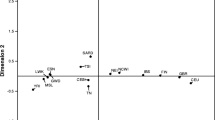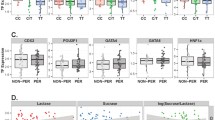Abstract
Lactase is the intestinal enzyme responsible for digestion of the milk sugar lactose. Lactase gene expression declines dramatically upon weaning in mammals and during early childhood in humans (lactase nonpersistence). In various ethnic groups, however, lactase persists in high levels throughout adulthood (lactase persistence). Genetic association studies have identified that lactase persistence in northern Europeans is strongly associated with a single nucleotide polymorphism (SNP) located 14 kb upstream of the lactase gene: −13910*C/T. To determine whether the −13910*T SNP can function in vivo to mediate lactase persistence, we generated transgenic mice harboring human DNA fragments with the −13910*T SNP or the ancestral −13910*C SNP cloned upstream of a 2-kb rat lactase gene promoter in a luciferase reporter construct. We previously reported that the 2-kb rat lactase promoter directs a post-weaning decline of luciferase transgene expression similar to that of the endogenous lactase gene. In the present study, the post-weaning decline directed by the rat lactase promoter is impeded by addition of the −13910*T SNP human DNA fragment, but not by addition of the −13910*C ancestral SNP fragment. Persistence of transgene expression associated with the −13910*T SNP represents the first in vivo data in support of a functional role for the −13910*T SNP in mediating the human lactase persistence phenotype.




Similar content being viewed by others
References
Bubner B, Baldwin IT (2004) Use of real-time PCR for determining copy number and zygosity in transgenic plants. Plant Cell Rep 23:263–271
Bubner B, Gase K, Baldwin IT (2004) Two-fold differences are the detection limit for determining transgene copy numbers in plants by real-time PCR. BMC Biotechnol 4:14
Buller HA, Grand RJ (1990) Lactose intolerance. Annu Rev Med 41:141–148
Buller HA, Kothe MJ, Goldman DA, Grubman SA, Sasak WV, Matsudaira PT, Montgomery RK, Grand RJ (1990) Coordinate expression of lactase-phlorizin hydrolase mRNA and enzyme levels in rat intestine during development. J Biol Chem 265:6978–6983
Enattah NS, Sahi T, Savilahti E, Terwilliger JD, Peltonen L, Jarvela I (2002) Identification of a variant associated with adult-type hypolactasia. Nat Genet 30:233–237
Enattah NS, Jensen TG, Nielsen M, Lewinski R, Kuokkanen M, Rasinpera H, El-Shanti H, Seo JK, Alifrangis M, Khalil IF, Natah A, Ali A, Natah S, Comas D, Mehdi SQ, Groop L, Vestergaard EM, Imtiaz F, Rashed MS, Meyer B, Troelsen J, Peltonen L (2008) Independent introduction of two lactase-persistence alleles into human populations reflects different history of adaptation to milk culture. Am J Hum Genet 82:57–72
Fajardo O, Naim HY, Lacey SW (1994) The polymorphic expression of lactase in adults is regulated at the messenger RNA level. Gastroenterology 106:1233–1241
Freund JN, Torp N, Duluc I, Foltzer-Jourdainne C, Danielsen M, Raul F (1990) Comparative expression of the mRNA for three intestinal hydrolases during postnatal development in the rat. Cell Mol Biol 36:729–736
Ingram CJ, Elamin MF, Mulcare CA, Weale ME, Tarekegn A, Raga TO, Bekele E, Elamin FM, Thomas MG, Bradman N, Swallow DM (2007) A novel polymorphism associated with lactose tolerance in Africa: multiple causes for lactase persistence? Hum Genet 120:779–788
Jensen TG, Liebert A, Lewinsky R, Swallow DM, Olsen J, Troelsen JT (2011) The −14010*C variant associated with lactase persistence is located between an Oct-1 and HNF1alpha binding site and increases lactase promoter activity. Hum Genet 130:483–493
Krasinski SD, Estrada G, Yeh KY, Yeh M, Traber PG, Rings EH, Buller HA, Verhave M, Montgomery RK, Grand RJ (1994) Transcriptional regulation of intestinal hydrolase biosynthesis during postnatal development in rats. Am J Physiol 267:G584–G594
Krasinski SD, Upchurch BH, Irons SJ, June RM, Mishra K, Grand RJ, Verhave M (1997) Rat lactase-phlorizin hydrolase/human growth hormone transgene is expressed on small intestinal villi in transgenic mice. Gastroenterology 113:844–855
Lee SY, Wang Z, Lin CK, Contag CH, Olds LC, Cooper AD, Sibley E (2002) Regulation of intestine-specific spatiotemporal expression by the rat lactase promoter. J Biol Chem 277:13099–13105
Lewinsky RH, Jensen TG, Moller J, Stensballe A, Olsen J, Troelsen JT (2005) T-13910 DNA variant associated with lactase persistence interacts with Oct-1 and stimulates lactase promoter activity in vitro. Hum Mol Genet 14:3945–3953
Olds LC, Sibley E (2003) Lactase persistence DNA variant enhances lactase promoter activity in vitro: functional role as a cis regulatory element. Hum Mol Genet 12:2333–2340
Olds LC, Ahn JK, Sibley E (2011) 13915*G DNA polymorphism associated with lactase persistence in Africa interacts with Oct-1. Hum Genet 129:111–113
Sebastio G, Villa M, Sartorio R, Guzzetta V, Poggi V, Auricchio S, Boll W, Mantei N, Semenza G (1989) Control of lactase in human adult-type hypolactasia and in weaning rabbits and rats. Am J Hum Genet 45:489–497
Swallow DM (2003) Genetics of lactase persistence and lactose intolerance. Annu Rev Genet 37:197–219
Tishkoff SA, Reed FA, Ranciaro A, Voight BF, Babbitt CC, Silverman JS, Powell K, Mortensen HM, Hirbo JB, Osman M, Ibrahim M, Omar SA, Lema G, Nyambo TB, Ghori J, Bumpstead S, Pritchard JK, Wray GA, Deloukas P (2007) Convergent adaptation of human lactase persistence in Africa and Europe. Nat Genet 39:31–40
Troelsen JT, Olsen J, Moller J, Sjostrom H (2003) An upstream polymorphism associated with lactase persistence has increased enhancer activity. Gastroenterology 125:1686–1694
Verhave M, Krasinski SD, Maas SM, Smiers FJ, Mishra K, Breeuwsma NG, Naim HY, Grand RJ (1995) Further characterization of the 5′-flanking region of the rat lactase-phlorizin hydrolase gene. Biochem Biophys Res Commun 209:989–995
Acknowledgments
The authors would like to thank Lynne Olds, Lydia Tsai, Christine Oo, Chris Brian Jackson, Alpna Kak and Charalambos Maravelias for excellent technical support and animal husbandry. This work was supported by the National Institute of Diabetes and Digestive and Kidney Diseases Grants DK60715, DK72416 and DK56339.
Author information
Authors and Affiliations
Corresponding author
Rights and permissions
About this article
Cite this article
Fang, L., Ahn, J.K., Wodziak, D. et al. The human lactase persistence-associated SNP −13910*T enables in vivo functional persistence of lactase promoter–reporter transgene expression. Hum Genet 131, 1153–1159 (2012). https://doi.org/10.1007/s00439-012-1140-z
Received:
Accepted:
Published:
Issue Date:
DOI: https://doi.org/10.1007/s00439-012-1140-z




